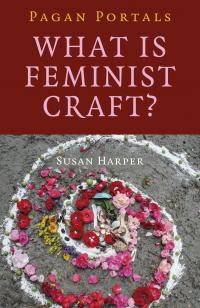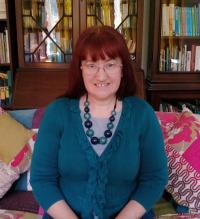
 I was on a brief visit to Aylesford Priory some time ago, when my attention was drawn to a
large statue of the Virgin Mary, shown in her role as Our Lady of the Assumption, and to the fact that she is depicted standing upon a crescent moon. The Priory is interesting in itself, and has some
resonances (dating back to a much earlier and pre-Christian period) with the wider network of ancient sacred sites in the Medway valley - I will most likely write about all that at some future point.
That statue, however, led me to reflect upon an important feature of the Goddess and of goddess-culture, a feature that has been particularly crucial at times over the past two millennia. That is,
the Goddess is a shape-changer, shifting her forms and identities as necessity demands.
I was on a brief visit to Aylesford Priory some time ago, when my attention was drawn to a
large statue of the Virgin Mary, shown in her role as Our Lady of the Assumption, and to the fact that she is depicted standing upon a crescent moon. The Priory is interesting in itself, and has some
resonances (dating back to a much earlier and pre-Christian period) with the wider network of ancient sacred sites in the Medway valley - I will most likely write about all that at some future point.
That statue, however, led me to reflect upon an important feature of the Goddess and of goddess-culture, a feature that has been particularly crucial at times over the past two millennia. That is,
the Goddess is a shape-changer, shifting her forms and identities as necessity demands.
This kind of shape-changing has been vital as a survival tactic in the face of ongoing repression, both on an individual level and throughout society as a whole. The monotheistic religions have proven themselves to be extremely jealous of their power both spiritual and secular, and especially keen to suppress any concept of the Divine Feminine. Yet, in spite of the very best efforts of priestly hierarchies, that same concept has a way of arising, revitalised, in the popular consciousness again and again.
Arguably, effective survival behaviour in itself can be seen as being associated with the feminine polarity. The relationship of that polarity, in terms of magical correspondences, to night and darkness, to flow and adaptation, to working with the rhythms and forces of Nature rather than trying to overrule them, is a close and powerful relationship. And these are the same values that enable the apparently weak or isolated individual, group or even culture to survive (as opposed to dominating) in situations of crisis, danger and hardship.
Instead of trying to use force to control circumstances, however temporarily, the Goddess teaches us how we may blend in, camouflaging ourselves to achieve a longer-term survival. The latter course is the more effective. Also (to borrow a terminology that I think has become fairly familiar), it could be considered a practical application of "power within" rather than "power over".
The considerable effectiveness of this way, and not only for the Goddess Herself, can be seen in the survival of key myths. The Mother Goddess transforms herself into the Madonna, then into Our Lady of the Assumption. The Horned God becomes the Green Man and continues to lurk in the stone forests of the cathedrals. Local deities and guardians frequently become saints and spirits of the dominating religion. Old festivals may change their names, but tend to keep their original meaning, at least for the common folk. The Inner essence of the myth of a God who sacrifices himself for the sake of the Land recurs, as the Mabon, as Mithras, as Odin, although maybe the Outer image shifts to suit external realities. And thus for those who are still willing to seek her out, the Goddess of the Land remains, too.
A continuation of mythology's Inner truth tends to emerge through the supremely malleable instrument of folklore, and folklore's remarkable ability to penetrate the dominant culture, creating a space within which ancient and unorthodox beliefs do not merely exist, but may actually flourish.
There is, unfortunately, always the danger of confusing the survival of myth with the existence of superstition. Warnings not to walk under ladders, and so on, do not really belong in the same category as the powerful metaphors hidden in so many stories and songs.
However, if we allow our own unconscious the opportunity, we are all capable of identifying the valid material. The point about myth, about its essential character, is that it is rooted within the human psyche. The fact is that should, by some remarkable twist of fate, every story and song, every scrap of folklore and magical belief, every trace of our knowledge of the sacred and the psychic, be completely effaced, we humans would simply begin to rebuild and reaffirm the whole structure. We would do this because it reflects our own Inner structure, our own nature.
Understanding this helps us to understand the re-emergence and re-establishment of the magical schools from the late 19th and early 20th Centuries, and especially of the various Pagan traditions from the 1950's onwards. None of these are invalidated by the lack of an unbroken genealogy stretching back into the mists of the past. They arise from the deepest wellsprings of humanity's mythic consciousness, and at least in that sense they may be considered as being part of a continuous tradition.
It is also possible to see a link, sometimes direct and sometimes indirect, with a long radical and subversive tradition. This might be an inescapable destiny for beliefs and concepts that, by their nature, run counter to established religions that are in their turn associated with the wealthy, the privileged and the powerful. However, the point is that the fundamental spirituality of humans is closely bound up with an inherent desire for both personal and collective freedom. And freedom, too, is a shape-changer.
Hence it is no accident that when justice and liberty are personified in art, they tend to appear as female. The Goddess, in a patriarchal society, necessarily becomes a rebel, a champion of the oppressed. If we forget or deny that, we are forgetting or denying who we are meant to be.
Categories:
0 comments on this article






